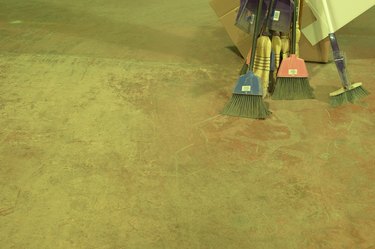Things You'll Need
Water
High-pressure hose
Stiff-bristled brush
Air hose or wet vacuum

Calcium deposits--also known as efflorescence—appear as a white substance on the surface of concrete. Efflorescence is the result of soluble salts being wicked to the surface of the concrete by moisture. When the moisture evaporates, the dried salts remain as a whitish residue. Efflorescence is extremely common, because soluble salts are found in the mixing water of the concrete and the soil that makes up the subgrade. Water can remove most efflorescence on concrete, but only a moisture barrier can prevent the movement of moisture from the subgrade to the concrete slab.
Step 1
Let the efflorescence run its course. Efflorescence tends to be a seasonal problem, and Rollrock.com explains that seasonal humidity provides the right conditions for efflorescence to appear. They estimate that the efflorescence should stop itself by about the third year. Tim Carter, of Askthebuilder.com, explains that the efflorescence stops itself if the soluble salt supply in the concrete is exhausted or the water supply is cut off, or the water in which the salts are dissolved is prevented from getting to the surface.
Video of the Day
Step 2
Make sure your concrete is properly cured. If you are pouring a new concrete floor, for example, ask your concrete mason to wet-cure the concrete. Wet-curing the concrete involves keeping the concrete wet for several days, then spraying it with a curing compound to retain the water necessary to fuel the chemical reaction that causes microscopic crystals to form. These crystals bind the concrete ingredients together and result in a much denser concrete with low water absorption. You are much less likely to have an efflorescence problem if the concrete is dense enough to prevent water from moving through it.
Step 3
Install a vapor barrier. Concreteconstruction.net explains that only a vapor barrier can prevent the movement of moisture from the subgrade to the surface of the slab.
Step 4
Wash it off. If you choose to allow the efflorescence to eventually stop itself, you will have to clean off the white residue whenever it appears. If you allow it to settle, it will react with carbon dioxide to form calcium carbonate or magnesium carbonate. These carbonate deposits are almost impossible to remove and require the use of an acid that can damage the concrete. First, use pressurized water and a scrub brush to remove the efflorescence, and then dry the area with an air jet or a wet vacuum to remove any standing water.
Video of the Day